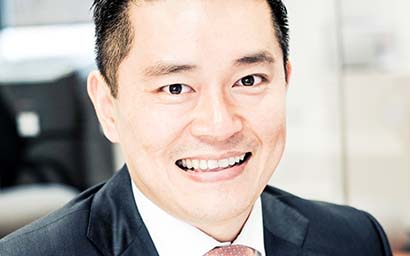 Funds Global Asia talks to Calastone’s Leo Chen about the impact of the pandemic on the adoption of automation across Asia’s funds markets.
Automation has been the dominant theme in asset management technology circles for years but while straight-through-processing has become well-established in Europe and the US, it is still yet to fully take hold across all of Asia’s asset management markets
The use of manual processes has been more prevalent in Asia than elsewhere for many years, thanks mainly to low labour costs. However the onset of the pandemic and the mass move to home working has spurred much greater interest in automation, especially in markets such as Taiwan, Malaysia, Indonesia and Thailand where automation rates lag behind not just the likes of Europe and the US but also more developed markets in Asia such as Hong Kong and Singapore.
“It has always been a hard conversation when we talk about operational costs reduction in Asia,” says Leo Chen, managing director and head of Asia at Calastone. “The normal argument is that both cost and operational risk are reduced when you replace manual processes with automation.”
“However, for decades the response among many Asian clients has been that the cost of manpower is cheap and they don’t make many mistakes, therefore the arguments in favour of automation have often proved less persuasive among market participants in the region,” says Chen.
In Asia’s major financial markets like Hong Kong and Singapore, this dynamic has developed over the last few years. Labour costs have risen, regulatory penalties for operational errors have increased and the model of employing staff to manually enter data has become outmoded. Technology has also become cheaper and more accessible.
Yet in other Asian markets and among smaller firms, the economic argument in favour of automation has remained challenging. The outlay for investing in technology and automation was higher than the cost of employing more manual labour.
And then Covid-19 came, bringing with it a global lockdown. “Almost overnight companies could not get access to their office and had to find a way to work remotely,” says Chen. For those companies that had adopted automation and other digital ways of working, the move to remote working proved less challenging. “It was possible to look at other markets where they were able to easily adjust because they had automated,” says Chen.
But for the large number of firms in Asia’s funds market that were reliant on manually processing physical statements or sending order confirmations by fax, the inability to get access to the office was a critical operational obstacle.
As a consequence, the interest in automation rose rapidly during this time, says Chen. “We had many more enquiries from firms looking to increase their use of automation and digitalisation.”
Across Asia, the fund distribution landscape is varied and this has influenced the rates of automation in the processing chain, says Chen. But Covid has proved to be a catalyst for change and call to action for the distributors and transfer agents.
“Fund managers have their funds distributed by large and small entities. The small ones have tended to be late to automation. They have carried on using old systems, maintaining that they don’t have that many orders so they don’t need to automate,” says Chen.
“But since Covid, fund managers have said to them that they need all of this to be automated. We sat down with clients and laid out all the various solutions,” says Chen.
For example, in addition to its straight-through processing, Calastone has also sought to provide a digital interface, Execution Management System, for firms to manage the entire trading process electronically with full visibility of all order flow, thereby enabling employees to be able to work from any location in complete security.
Calastone has subsequently seen rapid expansion in the region over the last 12 months, especially in Southeast Asia where a number of new clients have been signed, including the likes of Allianz PNB Life, GrabInvest, Manulife Investment Management (M) Berhad, Principal Asset Management, and UOB Asset Management.
This has been a significant step towards digitalising the region’s fund management industry, says Chen. He is also confident that, as the pandemic hopefully recedes and more normal working conditions resume, the focus on automation will not fade.
“The first step, in those early stages of lockdown, was to respond to an emergency situation and find a solution that clients could adopt straight away,” says Chen. “But now, the strategy is very different. Firms are looking for a sustainable approach that will make their operations more efficient and robust in the long-term.”
There is no one-size fits all approach to automation though, says Chen. “There are different levels of maturity in terms of technology and automation across the region. The likes of Hong Kong and Singapore are more advanced in automation but other countries are less mature and still scrambling to get their business up and running. We are telling them to be more prepared and to think ahead. The planning is so important.”
One of the historical obstacles to automation has always been the concern that it will reduce employment levels. However, there is a growing realisation that automation need not affect headcount and can actually benefit staff by reallocating roles.
A good example is the Taiwanese market, says Chen. “A number of fund management COOs would adopt automation with the express intention of slashing their headcount but instead found that their staff were retained and reallocated into new, more valuable roles – out of the back office and into positions of corporate governance, regulatory oversight, client reporting.”
Scalability will also be an important driver in the future, says Chen. For example, the fund management market in China is growing exponentially with micro-investing and the arrival of more overseas firms as the Chinese authorities removes the restrictions on foreign ownership of mutual funds companies operating in the mainland China.
It is always useful to compare the experience in one region to others, says Chen. And there is always a fear of the unknown which can hold back firms from making radical changes. But the stimulus from Covid added to the need for scalability and the accessibility has helped firms overcome the cultural concerns of old, says Chen. “The perception has definitely changed in Asia.”
© 2021 funds global asia
Funds Global Asia talks to Calastone’s Leo Chen about the impact of the pandemic on the adoption of automation across Asia’s funds markets.
Automation has been the dominant theme in asset management technology circles for years but while straight-through-processing has become well-established in Europe and the US, it is still yet to fully take hold across all of Asia’s asset management markets
The use of manual processes has been more prevalent in Asia than elsewhere for many years, thanks mainly to low labour costs. However the onset of the pandemic and the mass move to home working has spurred much greater interest in automation, especially in markets such as Taiwan, Malaysia, Indonesia and Thailand where automation rates lag behind not just the likes of Europe and the US but also more developed markets in Asia such as Hong Kong and Singapore.
“It has always been a hard conversation when we talk about operational costs reduction in Asia,” says Leo Chen, managing director and head of Asia at Calastone. “The normal argument is that both cost and operational risk are reduced when you replace manual processes with automation.”
“However, for decades the response among many Asian clients has been that the cost of manpower is cheap and they don’t make many mistakes, therefore the arguments in favour of automation have often proved less persuasive among market participants in the region,” says Chen.
In Asia’s major financial markets like Hong Kong and Singapore, this dynamic has developed over the last few years. Labour costs have risen, regulatory penalties for operational errors have increased and the model of employing staff to manually enter data has become outmoded. Technology has also become cheaper and more accessible.
Yet in other Asian markets and among smaller firms, the economic argument in favour of automation has remained challenging. The outlay for investing in technology and automation was higher than the cost of employing more manual labour.
And then Covid-19 came, bringing with it a global lockdown. “Almost overnight companies could not get access to their office and had to find a way to work remotely,” says Chen. For those companies that had adopted automation and other digital ways of working, the move to remote working proved less challenging. “It was possible to look at other markets where they were able to easily adjust because they had automated,” says Chen.
But for the large number of firms in Asia’s funds market that were reliant on manually processing physical statements or sending order confirmations by fax, the inability to get access to the office was a critical operational obstacle.
As a consequence, the interest in automation rose rapidly during this time, says Chen. “We had many more enquiries from firms looking to increase their use of automation and digitalisation.”
Across Asia, the fund distribution landscape is varied and this has influenced the rates of automation in the processing chain, says Chen. But Covid has proved to be a catalyst for change and call to action for the distributors and transfer agents.
“Fund managers have their funds distributed by large and small entities. The small ones have tended to be late to automation. They have carried on using old systems, maintaining that they don’t have that many orders so they don’t need to automate,” says Chen.
“But since Covid, fund managers have said to them that they need all of this to be automated. We sat down with clients and laid out all the various solutions,” says Chen.
For example, in addition to its straight-through processing, Calastone has also sought to provide a digital interface, Execution Management System, for firms to manage the entire trading process electronically with full visibility of all order flow, thereby enabling employees to be able to work from any location in complete security.
Calastone has subsequently seen rapid expansion in the region over the last 12 months, especially in Southeast Asia where a number of new clients have been signed, including the likes of Allianz PNB Life, GrabInvest, Manulife Investment Management (M) Berhad, Principal Asset Management, and UOB Asset Management.
This has been a significant step towards digitalising the region’s fund management industry, says Chen. He is also confident that, as the pandemic hopefully recedes and more normal working conditions resume, the focus on automation will not fade.
“The first step, in those early stages of lockdown, was to respond to an emergency situation and find a solution that clients could adopt straight away,” says Chen. “But now, the strategy is very different. Firms are looking for a sustainable approach that will make their operations more efficient and robust in the long-term.”
There is no one-size fits all approach to automation though, says Chen. “There are different levels of maturity in terms of technology and automation across the region. The likes of Hong Kong and Singapore are more advanced in automation but other countries are less mature and still scrambling to get their business up and running. We are telling them to be more prepared and to think ahead. The planning is so important.”
One of the historical obstacles to automation has always been the concern that it will reduce employment levels. However, there is a growing realisation that automation need not affect headcount and can actually benefit staff by reallocating roles.
A good example is the Taiwanese market, says Chen. “A number of fund management COOs would adopt automation with the express intention of slashing their headcount but instead found that their staff were retained and reallocated into new, more valuable roles – out of the back office and into positions of corporate governance, regulatory oversight, client reporting.”
Scalability will also be an important driver in the future, says Chen. For example, the fund management market in China is growing exponentially with micro-investing and the arrival of more overseas firms as the Chinese authorities removes the restrictions on foreign ownership of mutual funds companies operating in the mainland China.
It is always useful to compare the experience in one region to others, says Chen. And there is always a fear of the unknown which can hold back firms from making radical changes. But the stimulus from Covid added to the need for scalability and the accessibility has helped firms overcome the cultural concerns of old, says Chen. “The perception has definitely changed in Asia.”
© 2021 funds global asia  At times like these, HSBC Asset Management easily pivots towards emerging markets.
At times like these, HSBC Asset Management easily pivots towards emerging markets.
The spotlight on growth markets and the need to be nimble and dynamic is ever-sharper, given the difficulty in predicting monetary policy in the world’s major nations.

 A comprehensive, cost-effective, and transparent currency overlay hedging solution is crucial to mitigate FX exposure risks in the complex landscapes of Japan and China's FX markets, explains Hans Jacob Feder, PhD, global head of FX services at MUFG Investor Services.
A comprehensive, cost-effective, and transparent currency overlay hedging solution is crucial to mitigate FX exposure risks in the complex landscapes of Japan and China's FX markets, explains Hans Jacob Feder, PhD, global head of FX services at MUFG Investor Services. The world is transitioning from an era of commodity abundance to one of undersupply. Ben Ross and Tyler Rosenlicht of Cohen & Steers believe this shift may result in significant returns for commodities and resource producers over the next decade.
The world is transitioning from an era of commodity abundance to one of undersupply. Ben Ross and Tyler Rosenlicht of Cohen & Steers believe this shift may result in significant returns for commodities and resource producers over the next decade. Ross Dilkes, fixed income portfolio manager at Wellington Management, examines the opportunities and risks for bond investors presented by the region’s decarbonisation agenda.
Ross Dilkes, fixed income portfolio manager at Wellington Management, examines the opportunities and risks for bond investors presented by the region’s decarbonisation agenda. Shareholders in Japan no longer accept below-par corporate governance standards. Changes are taking place, but there are still areas for improvement, says Tetsuro Takase at SuMi Trust.
Shareholders in Japan no longer accept below-par corporate governance standards. Changes are taking place, but there are still areas for improvement, says Tetsuro Takase at SuMi Trust. Robert St Clair, head of investment strategy at Fullerton Fund Management, explores the reasons investors should be paying attention to the rising demand for healthcare in China.
Robert St Clair, head of investment strategy at Fullerton Fund Management, explores the reasons investors should be paying attention to the rising demand for healthcare in China.


